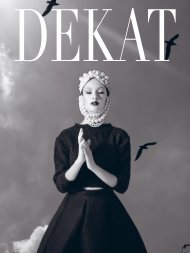DEKAT DIGITAL 2019 - 2020
DEKAT Magazine is the custodian of Afrikaans Culture. Well known for exceptional photography and design, the 2022 luxury edition will delight you. You will find topical lead articles, lifestyle articles focusing on art, culture, design and décor, motoring, food and wine and travel. In addition, we find hidden stories, meet extraordinary people and share divine recipes with you. The 320-page book is a unique window into the lives of the Bohemians and the Eccentrics living on the Southern tip of Africa.
DEKAT Magazine is the custodian of Afrikaans Culture. Well known for exceptional photography and design, the 2022 luxury edition will delight you. You will find topical lead articles, lifestyle articles focusing on art, culture, design and décor, motoring, food and wine and travel. In addition, we find hidden stories, meet extraordinary people and share divine recipes with you.
The 320-page book is a unique window into the lives of the Bohemians and the Eccentrics living on the Southern tip of Africa.
Create successful ePaper yourself
Turn your PDF publications into a flip-book with our unique Google optimized e-Paper software.
Olu Oguibe wrote his own textbook, The Culture Game (2004, University<br />
of Minnesota Press), for one of his courses at the University of Nigeria,<br />
Nsukka, because Contemporary African Art has only fairly recently<br />
become a field of study. But on the academic conference circuit, the<br />
notion of Contemporary African Art is better explored, and scholarly<br />
presentations and papers are adding to the rapidly growing archive of<br />
research. Noteworthy publications include Reading the Contemporary:<br />
African Art from Theory to the Market Place (1999, Institute of International<br />
Visual Arts, edited by Olu Oguibe and Okwui Enwezor), Antinomies of<br />
Art and Culture; Modernity, Postmodernity, Contemporaneity (2008, Duke<br />
University Press, edited by Okwui Enwezor, Nancy Condee and Terry Smith) and most recently, Former West:<br />
Art and the Contemporary After 1989 (2016, BAK, by Maria-Kyveli Mavrokordopoulou).<br />
The Goethe Institute has played an important role in the advancement of critical and intellectual thinking about<br />
Contemporary African Art and three major publications have been initiated by this organisation: Positions:<br />
Contemporary Artists in South Africa (2010), Über(w)unden: Art in Troubled Times (2012) and African Futures:<br />
Thinking about the Future in Word and Image (2016). The latter is particularly insightful about the different<br />
genres of Contemporary African Art, including, for example, graphic science fiction novels/comics set in<br />
the distant future in Cairo; music videos with singers dressed in what can only be described as a fusion of<br />
traditional and contemporary Zimbabwean dress; performance art pieces that are closely aligned to traditional<br />
masquerades; and contemporary African fashion design and photography. Another noteworthy publication is<br />
Ashraf Jamal’s In the World: Essays on Contemporary South African Art (2017, Skira).<br />
Academic and popular journals are growing the body of published scholarship. They include Nka: Journal of<br />
Contemporary African Art, Third Text, Art Africa, and Diptyk: Art from Africa and the Arab World. Independent<br />
projects such as Corrigall & Co’s research reports – A Decade of Curating (2018) and The Top 50 Artists and<br />
the Top 20 Curators who Validated Them (<strong>2019</strong>) – add significantly to our understanding of what they call<br />
the ‘Contemporary African Art Ecology’. The ArtTactic Market Analysis reports on the performance of modern<br />
and contemporary African artists in the auction market from 2016 to <strong>2019</strong>, and Hans Ulrich Obrist’s ongoing<br />
research project, 89+, is also making a significant contribution.<br />
Leading auctioneers have added Contemporary African Art to their sales and Sotheby’s regularly sell work by<br />
artists such as William Kentridge, Pascale Marthine Tayou, Chéri Samba, Bodys Isek Kingelez, Ben Enwonwu,<br />
El Anatsui, Julie Mehretu, Yinka Shonibare, Chris Ofili and Wangechi Mutu, as does Bonhams, London, in<br />
its annual Africa Now sale. In South Africa, leading auction house Strauss & Co successfully launched a<br />
Contemporary Art sale in February 2018 to coincide with the annual Cape Town Art Fair, and this initiative<br />
grew in scope and value with the second iteration in <strong>2019</strong>.<br />
The depth of attention being paid to contemporary African art and the growing understanding of the phenomenon<br />
is graphically illustrated by the new digital platform series initiated by Tate Modern, Yes, But Why? The first<br />
episode, on Zanele Muholi, provides 10 unequivocal answers to why she is currently regarded as the most highly<br />
rated contemporary artist: she was born at the height of apartheid in South Africa; she identifies as a visual<br />
activist, rather than an artist; her work represents and empowers the LGBTQIA+ community; she creates grassroots<br />
collectives to support the community; she photographs participants, not subjects; her early work creates a new<br />
picture of lesbian identity; her work celebrates black skin; she creates powerful portraits, shot internationally; her<br />
relationship with her mother is very important to her; and her practice is about inner and outer beauty.<br />
Contemporary African Art has come a long way, exemplified by the manner in which the centre of Western Art now<br />
acknowledges and celebrates art and artists from Africa. It has gained a strong identity over the past 30 years and the<br />
art metropole is in all likelihood shifting from Paris, Berlin, London and New York to Cairo, Lagos, Nairobi, Kinshasa<br />
and Johannesburg. We look forward to a second generation of contemporary African artists, curators and scholars,<br />
and a new wave of Contemporary African Art exhibitions, projects and publications, with excited anticipation.<br />
58





